#1910s chandelier
Explore tagged Tumblr posts
Photo

Art Nouveau Bronze Chandelier by Hector Guimard with nickel finish and dark blue pate de verre.
For sale: 1stDibs
#1910s#art nouveau#chandelller#hector guimard#guimard#bronze#pate de verre#art nouveau chandeller#art nouveau chandelier#chandelier#beautiful chandelier#art#french art#french chandelier#art nouveau style#1910s chandelier#Guimard Chandelier#interior#art nouveau interior#la belle epoque#belle epoque
58 notes
·
View notes
Text










Instagram: iliketoseeeverythinginneon
#time capsule house#soho#New York#nyc#real estate#zillow#zillowcore#interior#interiors#1915#1910s#10s#Ken fulk#art deco#emerald#chandelier#leopard#wallpaper#checkerboard#breakfast nook#jungle#swan
32 notes
·
View notes
Text

Ridiculously expensive, spectacular 1910 mansion in New York City. 8bds, 9ba, 12,000 sq ft (it's huge), $55m. It's not selling, probably b/c not many people have $55m. There's also an HOA fee b/c it's a townhome and there's maintenance and elevators, but they don't give the monthly cost.

The wood looks original. So, built in 1910, it would've been just 10 yrs. before the Art Deco movement.

Here's a sitting area that's not a living room, just kind of a lounge by the piano.

In the living room there's an incredible fireplace with a surround that appears to depict the Pilgrim's landing in America.

In this sitting room, the wood is amazing, and look at the stained glass ceiling.

The dining room is round. The floor is gorgeous, and I'm wondering if the table is actually built-in. Note the carvings.

The ceiling is unusual and I can't believe that the round table seats 12. It looks tight, though.

This sitting room has a beautiful fireplace, plus tile doors on the cabinets. I wish they would've shown more of the ceiling.

This is crazy- the huge kitchen island has a copper farm sink and a gold-trimmed leather counter.

Cute little terrace has a marble railing.

Look at the sculpture on that newel post.

Another gorgeous fireplace.

Would you believe that this is the closet? Insane. The chandelier alone is massive.

More stairs. Where are these elevators? This landing has room for a table and there's a mural, too.

This sitting room is all wood with insets. Geesh.

Look at the intricate carvings.

What a fabulous sun room.


The sun room is surrounded by this fabulous roof top deck that has a view of the Hudson River.

So, clearly this is the corner unit.

The front door seems so vulnerable, b/c it's so close to the sidewalk.





https://www.zillow.com/homedetails/25-Riverside-Dr-New-York-NY-10023/143131834_zpid/
186 notes
·
View notes
Text
Prime Video is developing The Davenports, a series based on Krystal Marquis’ bestselling YA novel of the same name, from Alloy Entertainment. The project is a co-production of Warner Bros. Television and Amazon MGM Studios.

The series, set in 1910 America, revolves around the Davenports, who are one of the few Black families of immense wealth and status thanks to the entrepreneurship of former enslaved patriarch William Davenport. Surrounded by servants, crystal chandeliers, and endless parties, his daughters Olivia and Helen, and their friends, are finding their way and finding love—even where they’re not supposed to.
Leslie Morgenstein and Gina Girolamo executive produce for Alloy Entertainment. Warner Bros. Television and Amazon MGM Studios are the studios. A search is underway for a writer.
The Davenports was released in 2023 and Marquis is currently working on book two in the series.
100 notes
·
View notes
Text
Hector Guimard, Chandelier, 1909
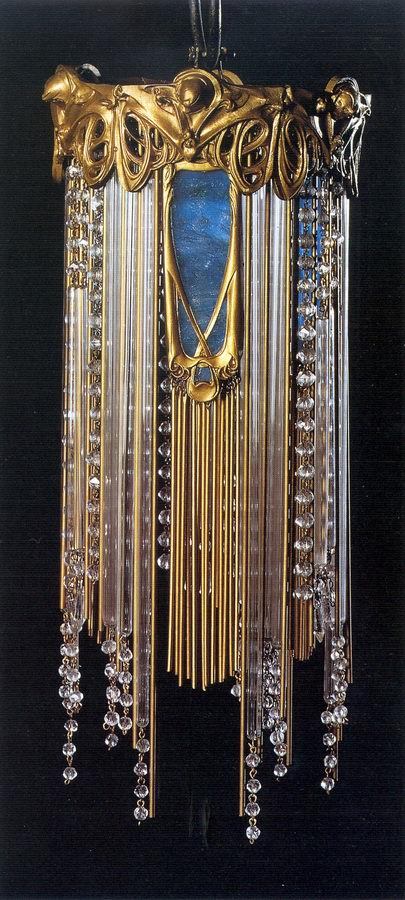
"Chiselled golden bronze, coloured glass, beads and glass tubes, brass and copper structure. 41 x 19 cm. Musée d'Orsay, Paris.
Guimard executed the drawing for this lamp in 1909 and patented it in 18 August 1910."
Scanned and quoted from the book "Art Nouveau" by Gabriele Fahr-Becker.
44 notes
·
View notes
Text








By Troy Lennon /Daily Telegraph; May 5, 2018
Gaston Leroux was inspired to write Phantom of the Opera after Palais Garnier accident
WHEN a counterweight crashed through the roof of a Paris opera house, Gaston Leroux stored the story away to help create the Phantom of the Opera.
THERE had long been rumours that a ghost walked the halls of the opera house in Paris, known as the Palais Garnier. Some dismissed it as superstition, but many believe that confirmation came on May 20, 1896, during a performance of the opera Helle, by Étienne-Joseph Floquet. Act one had just finished and the audience had called for an encore from soprano Madame Rose Caron. As she finished her aria a loud noise was heard through the auditorium, followed by a crash and a cloud of dust.
A fire in the roof of the opera house had melted through a wire holding a counterweight for the chandelier. The weight had crashed through the ceiling injuring several people and killing Madame Chomette, the concierge of a boarding house, who was watching her first opera.
Some newspapers reported that the chandelier itself had crashed to the stage. Gaston Leroux, a journalist working for the newspaper Le Matin, read about the accident and used it, and the rumours of a ghost, as inspiration for a story about a disfigured man who menaces the cast and stage crew of an opera company at the Palais Garnier. Titled Le Fantôme de l’Opéra, it was first serialised in the periodical Le Gaulois in 1909 and as a novel in 1910. It was published in English as The Phantom of the Opera.
Leroux, who was born 157 years ago, was mostly known for his detective fiction, which inspired writers such as Agatha Christie. Yet outside France he is really only known for the Phantom, a story that has inspired plays, films and a hit Andrew Lloyd Webber musical.
Gaston Louis Alfred Leroux was born on May 6, 1868. His parents were travelling in a coach from Le Mans to Normandy when they had to stop so his mother could be taken to a nearby house to deliver the baby.
His father was a wealthy shipbuilder and Leroux lived a comfortable childhood, with a love of sailing, fishing and swimming. Straight out of school he went to work as a clerk in lawyer’s office, but spent his spare time writing stories and poetry. He was then sent to university to study law, winning awards and prizes and giving every indication that he was headed for a glittering law career.
But when his father died in 1889, leaving him a million francs, Leroux sank into a life of self-indulgence, gambling, going to the theatre and partying so hard he ended up broke after six months.
Faced with the need to work and frustrated by the legal system, Leroux pursued writing, taking jobs as a theatre critic and court reporter. By 1890 he had become a full-time journalist, impressing his editors by using forged credentials to score an interview with a high-profile prisoner awaiting trial.
His expertise in law also saw him reporting on the Dreyfus Affair, when anti-semitic elements in the French army conspired to accuse Jewish officer Alfred Dreyfus of espionage, seeing him drummed out of the army and sentenced to life in prison in 1894. Leroux described Dreyfus’s trial as a farce and was one of the many journalists who campaigned to free Dreyfus.
Leroux also became a foreign correspondent travelling the world, including to Africa and Antarctica. He even reported on the 1905 revolution in Russia, although at times using his flair for creative writing to embellish his copy. At the time he could be relied on to boost circulation with his colourful stories.
But Leroux tired of being at the beck and call of editors, decided to concentrate purely on his forays into fiction. He had been publishing short stories in newspapers for years, so in 1907 he published his first novel, Le mystère de la chambre jaune (The Mystery of the Yellow Room), introducing amateur sleuth journalist Joseph Rouletabille. Inspired partly by his own experiences as a court reporter and Arthur Conan Doyle’s “consulting detective” Sherlock Holmes, it was light on action but struck the right balance of mystery and intellect to appeal to French readers.
He followed this with many other mystery novels featuring Rouletabille but, in between, he wrote other novels, including The Phantom of the Opera.
After several of his works were adapted to film he realised the cinematic potential of his fiction and in 1919 formed a film company with another writer, Arthur Bernede, to make films of his own novels and plays.
In 1922 Leroux gave a copy of Phantom to the head of Universal Pictures, Carl Laemmle, while Laemmle was visiting Paris. It resulted in the 1925 Lon Chaney adaptation, which made Leroux’s name famous outside France and helped him pay off gambling debts.
Some of his other works were also adapted to film in the US, but his detective works, despite winning fans like Christie, were not as popular in the English-speaking world.
Leroux died in Nice in 1927.
#Gaston Leroux#Le Fantôme de l'Opéra#The Phantom of the Opera#Paris Opera#Palais Garnier#Opera Garnier#Christine Daaé#classical music#opera#music history#composer#bel canto#classical composer#aria#classical studies#maestro#chest voice#architecture#classical musician#classical musicians#classical history#history of music#historian of music#musician#musicians#diva#prima donna#The Phantom#author#fiction
8 notes
·
View notes
Photo

Hedda Sterne (Romanian-American,1910-2011)
The Chandelier, 1945
206 notes
·
View notes
Text
The Riviera Theater, Uptown, Chicago
4746 N Racine Ave, Chicago, IL 60640
Opened Oct. 2, 1918
C.W. Rapp and George Rapp, architects
Balaban & Katz, original owners
Seating Capacity: 2,500
Jam Productions, current owners
Current use: Concert venue
Completed in 1917 by architects George and C.W. Rapp (Rapp & Rapp), it was built as a movie theater for the Balaban & Katz chain. Transformed into a private nightclub in 1986, the Riviera Theatre is now one of Chicago’s premier concert and special events venues.
Jam Productions website https://www.jamusa.com/venues/riviera-theatre

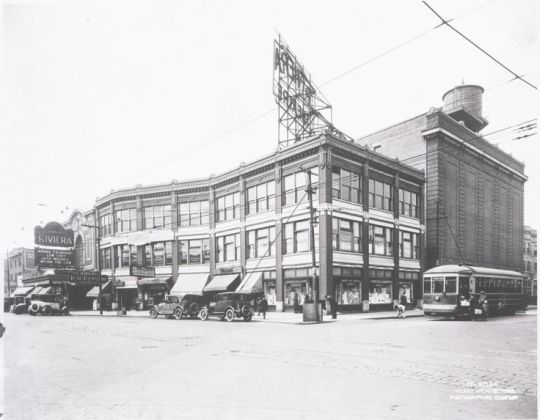
Broadway and Lawrence, Uptown


Two theaters: the Riviera and the Uptown
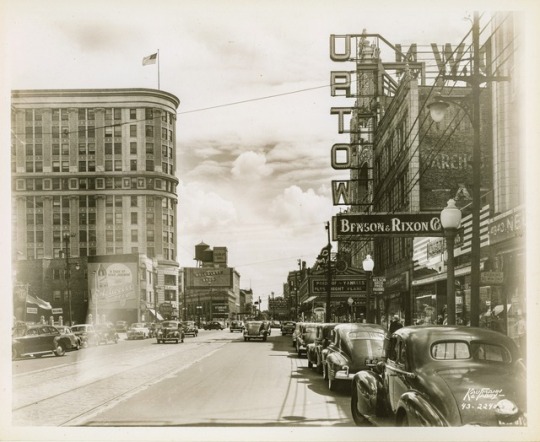

Photo on display in the Riviera lobby, showing original chandelier, now gone, and the box office, which remains

The Riviera Theatre was the largest and most ornate of the movie theatres of the Uptown neighborhood until the opening of the Uptown Theatre almost a decade later. Opened October 2, 1918 with Lina Cavalieri in “A Woman of Impulse”. Built at a cost of well over half a million dollars (delayed by almost two years due to World War I), this Rapp & Rapp-designed house located on N. Racine Avenue between Broadway and W. Lawrence Avenue, originally seated 2,600 and its building also featured eight storefronts and over 30 apartments. Initially the Riviera Theatre was to have been operated by the Jones, Linick & Schaefer chain, which operated several Loop movie houses in the 1910’s and 1920’s such as the Orpheum Theatre, the Rialto Theatre, and the McVickers Theatre. However, the Riviera Theatre ended up becoming the second major theatre of the Balaban & Katz circuit, which at the time also included the Central Park Theatre, now regarded as Chicago’s first true ‘movie palace’. Featuring movies accompanied by the orchestra of S. Leopold Kohl, the Riviera Theatre also featured “high class” musical acts on stage. It was initially equipped with a Barton theatre organ which was later replaced by a Wurlitzer organ. The theatre mainly catered to the upper-middle class residents of the Uptown area, especially women. The Riviera Theatre continued to remain one of the neighborhood’s most popular movie houses for decades, even once the almost 4,500-seat Uptown Theatre opened just down the street. By 1977 it was in its final days as a full-time movie theatre as occasional live concerts were beginning to be staged. It became first a nightclub in 1986, and a few years later, after the nightclub closed, one of Chicago’s most popular concert venues, as it remains today. It still has a feel of faded elegance to it, and in 2000 the concert hall was named one of the historically important structures making up the Uptown Square National Historic District.
www.cinematreasures.org
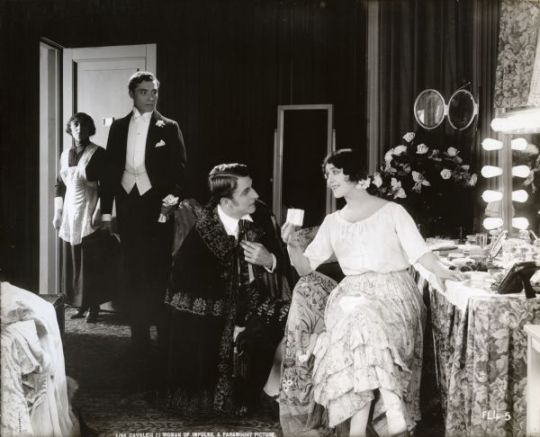
In a scene still from the American drama film A Woman of Impulse (1918), Leonora, the opera singer known as "La Vecci" (played by Lina Cavalieri) sits in her backstage dressing room receiving visitors.
The Riviera Theater was open to the public on the weekend of October 14-15, as part of the Open House Chicago weekend sponsored by the Chicago Architecture Foundation. It was my first time inside the theater.
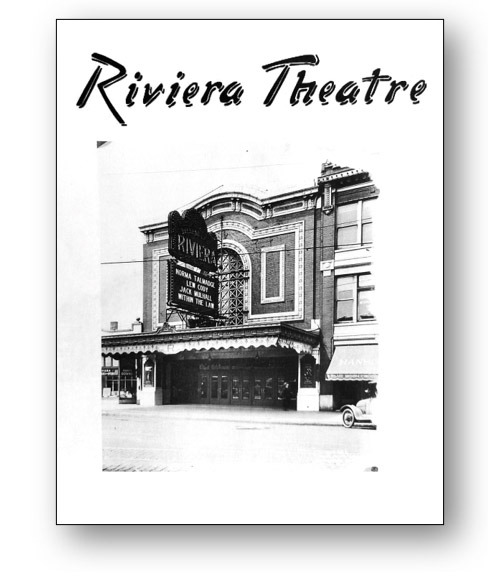
Jam Productions thoughtfully provided a booklet with a history of the Riviera and reproductions of archival photos. A couple of the images are scanned below.
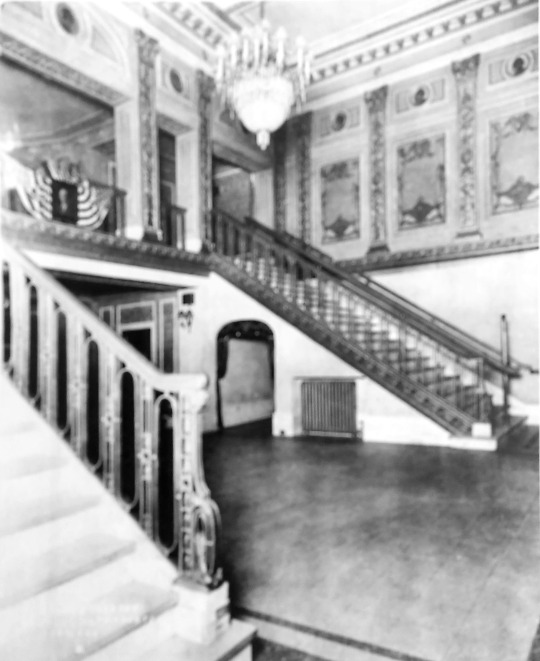
Theater lobby
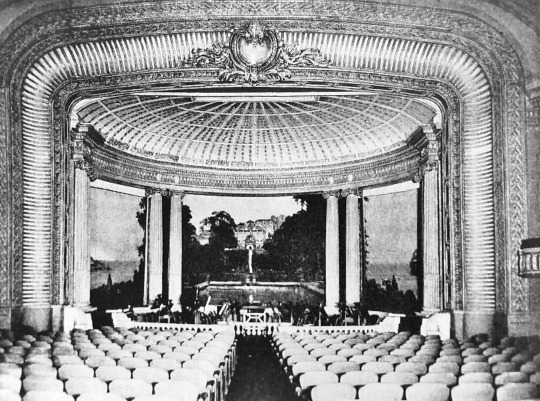
Such stage sets were often inserted for the performance of "prologues" or musical numbers before the movie screen would be lowered for the film showing.
As usual, interior photography is difficult without a tripod, and though some of these images are blurry, they give a good impression of what remains a stunning interior.
Sometimes thought of as a "companion" to the much larger Uptown theater just across Lawrence on Broadway, the Riviera was built first, and inspired the slightly later Chicago Theater in the Loop.
The purple wall color is not original, but there are no current plans to change it to the muted tones of the original scheme. A couple of original stencil designs have been uncovered in the lobbies, which will eventually be reproduced. The murals in the auditorium are faded and covered by grime and nicotine, but being backed by heavy paper rather than canvas, their restoration will prove tricky, and there is no current timeline for this process.
I was a bit mystified by the lack of theater seats on the main floor, which resembles a large concrete-floored nightclub rather than a theater. Never having been to a concert in this venue, I imagined what a standing-room crowd would experience here. the balcony level, however, has recently-installed theater seats, and seems a comfortable place from which to enjoy music.
The lobby features one of the original chandeliers from the Granada Theater in Rogers Park; somewhere there is a companion piece, which Jam hopes to acquire eventually for the outer lobby. The huge light fixture isn't exactly elegant; seen from the upper lobby, its design seems rather awkward. That, in my opinion, is one of the weaknesses of early movie palaces, which strove for an overall "wow" effect rather than architectural refinement or historical accuracy of detail.
Here are my photographs from my visit to the theater on October 14:
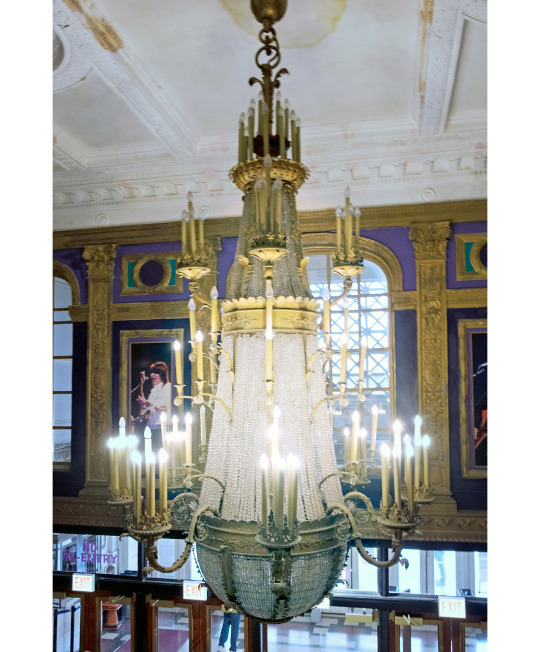
The Granada chandelier in the Riviera lobby
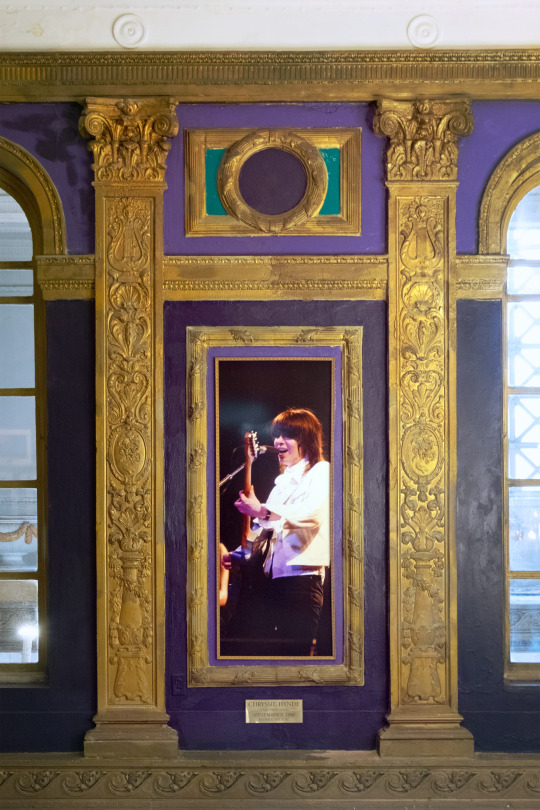
That's Chrissie Hynde
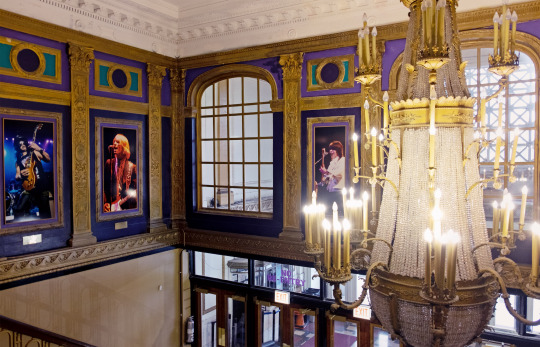





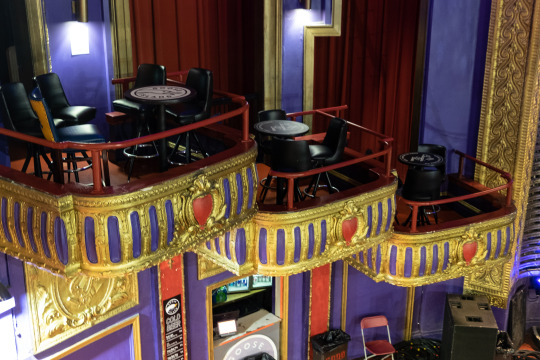
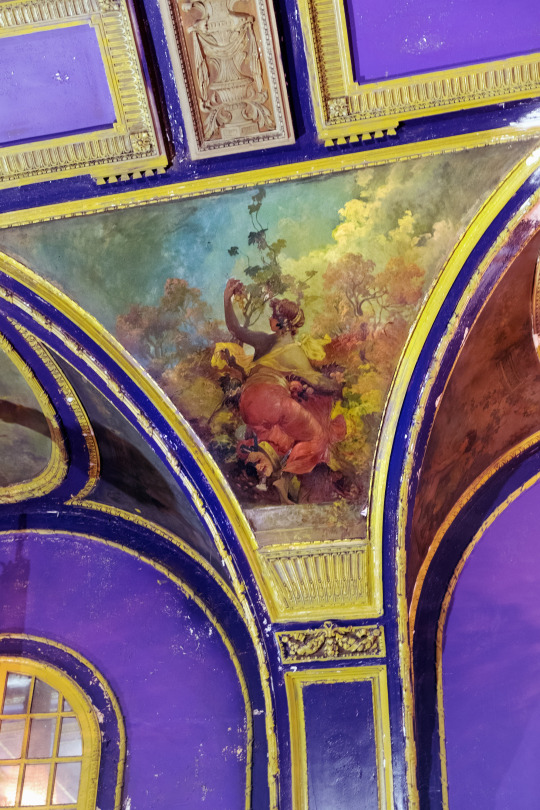
One of the depictions of the four seasons in the auditorium. The painting isn't nearly this clear or colorful; it's been Photoshopped. It appears muddy as in the next photo.
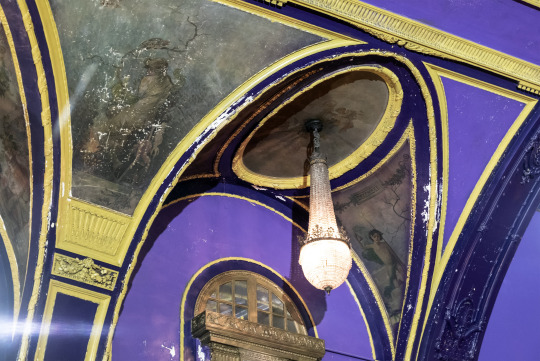
The six side light fixtures were later additions, and were simply hung from the center of the oval paintings.

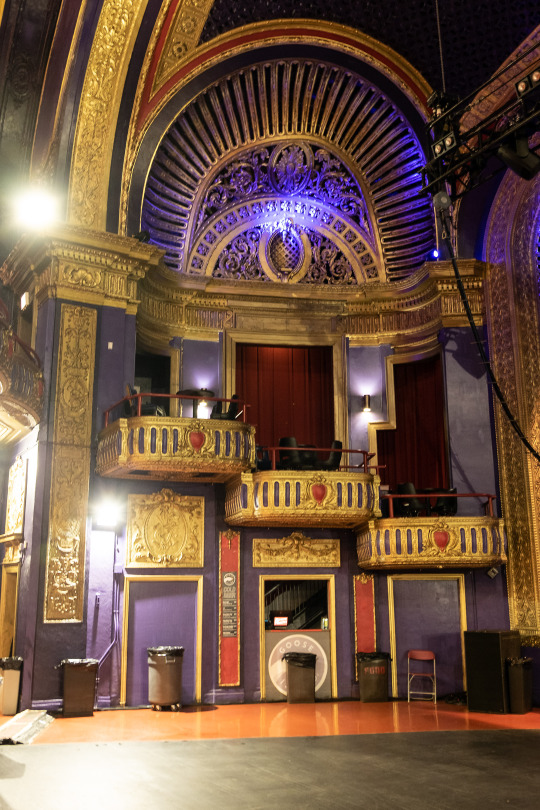
#Chicago#architecture#movie theater#cinema#movie palace#Riviera Theater#Uptown#Open House Chicago#Rapp and Rapp#Balaban and Katz#Jam Productions
46 notes
·
View notes
Text
Take My Hand P11
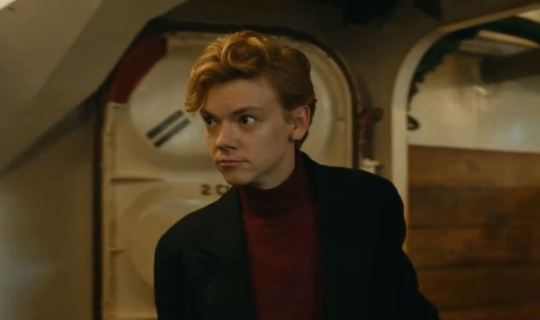
Media Irl x 1910
Character Thomas Brodie Sangster
Couple Thomas X Reader
Rating Adorable
Concept Take My Hand Series
|Y/n|
I had a nice hot shower luckily not many others were showering around this time so lots of hot water making sure to wash my hair and make myself smell nice. I sat on my rooms sofa curling my hair while I got my best dress on, my little blue dress I was bringing with me for after we arrived I hadn't planned to wear it onboard but this felt right, it was such a sweet dress not impressed by any means but such a sweet color with beautiful embroidery I did very little make up just a lip and some eye work as I didn't want to seem too overdressed using my little white shoes and my gloves in the hope it would bring it all together I let my hair from the curls and plaited It. I grabbed my journal and a small bag doing a final spin to check myself over.
The door to my room then knocked to I hid some mess away and opened It seeing Thomas stood rather well dressed seeming at first confused and worried but relieved when he saw me
"Thank goodness I got lost for a while there" he laughed making me giggle too "you- you look so beautiful" he smiled looking me over
"Thank you I did my best, you look handsome'
"Ohh thank you, may I?' he asks offering his hand I nodded and he took my hand giving it a gentle kiss "I got really lost for a while. I didn't realize quiet how far down it was"
"That's okay, so shall we go? If you still want to, of course?"
"Of course I do" He smiled
I held his arm as he lead me up though the ships many decks each getting more impressive the higher we went, until we reached this beautiful deck of marble floors, mahogany fixings, electronic lights hung in beautiful chandeliers I stopped short as we arrived at a stairwell, a bustling lobby below of women dressed in diamonds and men in fine suits, I felt immediately out of place stopping short letting his arm leave my grip. He stopped half way down the stairs as he noticed I wasn't with him and he turned back to me
"I uhh I shouldn't be here"
"You're fine your on my invitation." He smiled
"I think I'm uhh a little underdressed'
"You look beautiful, take my hand I promise I'll look after you" he smiled offering his and I was nervous but I took it letting him lead me down the stairs and thought a corridor or two until we reached the glass plane doors of the restaurant, we had to show our documents to the host and immediately he pulled a face
"This is a third class passenger Sir"
"Yes, I invited her to dinner I have it all sorted if you continue with the paperwork"
"Sir I-"
"It should be shorted. she's here by invitation"
"Have a pleasant evening" He says handing back our paperwork and we were lead inside this beautiful well decorated dinning room with a fireplace and tables all around the room, we were given a table on our own near the fireplace there were so many sets of cutlery and a menu long enough it took up the whole page
"Holy toad." I muttered looking at the menu "How many courses?"
"Ten" He smiled "it's my treat. get whatever you like" He smiled
"Uhhhh okay" I nodded "anything you recommend?"
"The Fillet was nice last night" he smiled eventfully we ordered even if I needed a lot of help and they took our menu's, it wasn't long till the first small soup arrived "Start at the edge work your way in" He told me
"Right" I giggled "sorry"
"It's fine, it's always sweet to see people learn it" He laughs
we ate and chatted for a good while about everything and nothing and it was so much fun the two of us laughing and joking between the two of us the courses luckily were small so it wasn't too hard to have something from all of them even if we mostly shared what we got
"Ahh my favourite course" He smiled as our desert arrived I got peaches in jelly and he got some eclairs but we got ice cream between us "Ummm that's good. One thing I will say about the first class kitchen's they make good pudding"
"Umm it is really nice, never had peach jelly before"
"How is it?"
"Here" I smiled offering him a spoonful
"oohh? that is good." He smiled "Ohh here." He smiled giving me half of his éclair
"Thank you" I giggled "Umm very nice"
"Ice cream's good too."
"I've had better"
"Ohh? enlighten me?"
"There is this little farm close to where I use to live they make the best ice cream,"
"You'll have to take me someday"
"I'd Love too"
Once dinner was done with we went for a walk across the deck in the darkness
"I had a lovely time Thomas"
"I had an amazing time with you too"
"Ohh I stole this from the hosts cart before we left" he smiled grabbing a menu from his pocket "for your journal"
"aww thank you so much" I smiled adding it to my journal for tonight
"May I say something that might sound rather insane?"
"...Of course."
"I really like you y/n"
"Ohh" I blushed hard "I uhh I really like you too Thomas."
"do you think I could come see you again tomorrow?"
"I'd like that"
"You would?"
"I would" I nodded
"Okay...Did you want me to walk you back?"
"If you wouldn't mind"
"not at all, I want to make sure you get back to your cabin safe" He reassured
"Okay"
#tbs smut#tbs imagine#tbs imagines#thomas sangster imagine#thomas brodie sangster imagine#thomasbrodiesangster#thomas brodie sangster smut#tbs#thomas brodie sangster#thomas sangster
13 notes
·
View notes
Photo
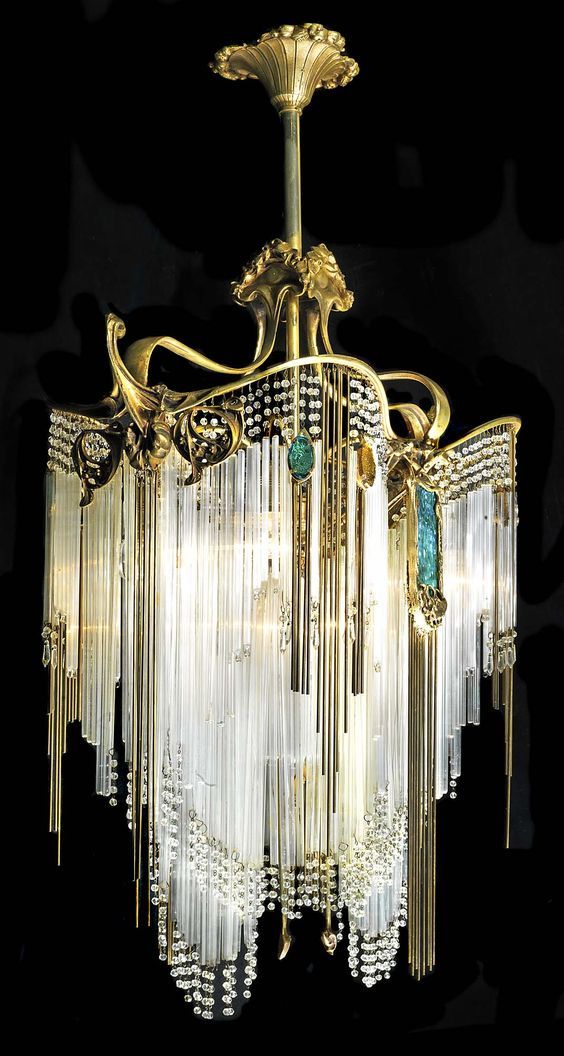
1910 Hector Guimard chandelier, Westland London. Art Nouveau.
776 notes
·
View notes
Text
i was tagged by @ashadeintheshade, so it's time to keep the game going! ;)
tag someone you want to know and/or some of your besties:
favorite color: blue! i also love lavender
last song: bert kaempfert's version of 'three o'clock in the morning'
last movie: 'a christmas story' on xmas day! even though i didn't stick around for it after dinner since i've seen it dozens of times
currently watching: dan and phil text each other 4! it's mostly on in the background, but i'm peeking in every once in a while ;)
other stuff i watched this year: i watched a lot of 1890s-1910s movies for my film history class! 'gertie' is the most iconic one! ;)
currently reading: i just finished reading 'lila goes for gold'! i thought it would be like other girl of the year books from ag, but i was pleasantly surprised by how fresh it felt
currently listening to: the dnp vid! ;)
currently working on: the big chandelier scene in erik's pov story!! :D
current obsession:

@jennyfair7
3 notes
·
View notes
Text
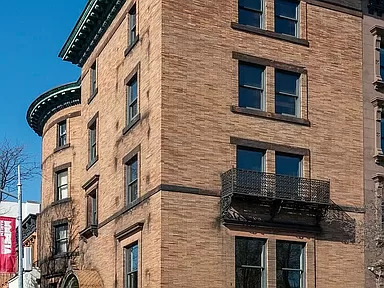


Thanks to tasmanienerin for sending this dreamhouse of mine, a 1910 mansion in New York City. I'm surprised to see that the 6bd, 5ba home is actually original. (Did you notice the streets carved into the corner of the house?) $7.25M. I HOPE that the millionaire who buys it doesn't give a modern renovation and ruin it.

All the wood, including the floor, is original. It has a large nook with a round stained glass window, and built-in cabinets on each end. Love the gold-on-blue wallpaper.

The grand entrance hall is very large and has a beautiful chandelier. The hall is placed differently than other Victorians- it's sideways, so when you enter, the stairs are built facing "east/west," against the wall.

The owners chose to paint the reception room a sunny yellow and the corner room does get a lot of sun. It has a beautiful fireplace, gorgeous crown molding, wainscoting, and ceiling. It's such a large room, it fits 2 baby grand pianos with space to spare.

I think that this is the 2nd reception room, but they have it set up as a casual dining room. There's a fireplace and wainscoting, but the molding isn't as grand and the ceiling is plain. It does have a great chandelier, though.


This long room is the actual dining room. It has the high wainscoting and a grand fireplace. Look at the design in the ceiling.

I couldn't wait to see the kitchen, and it's basically intact. The stove is placed in the original cooking fireplace, there're no new cabinets except for a sink, but they do have a large commercial fridge. The table is huge. I love it. But, I would bet that someone's going to buy the house and completely gut it.

The home has 6 floors and this is a large landing. Notice the fancy stairs on the right, and across the way, behind a door, are the former staff stairs.

No doubt about it- there's a lot of climbing, b/c an elevator was never installed.

On this upper floor, there may be the staff rooms. It's unusual to see wainscoting on the upper levels.

Well, we can see that this bath is original. I hope someone doesn't come in and put up big tile showers and jetted soaking tubs.

I see that on the 3rd fl. there's a reading room.
https://www.zillow.com/homedetails/1-W-123rd-St-New-York-NY-10027/2126331513_zpid
#victorian mansion nyc#victorian mansions#mansions#old house dreams#houses#house tours#home tour#submissions
179 notes
·
View notes
Photo


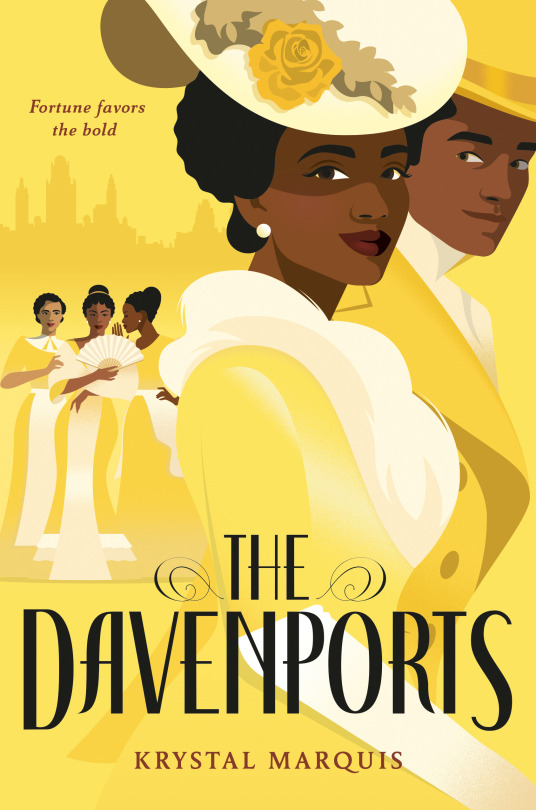
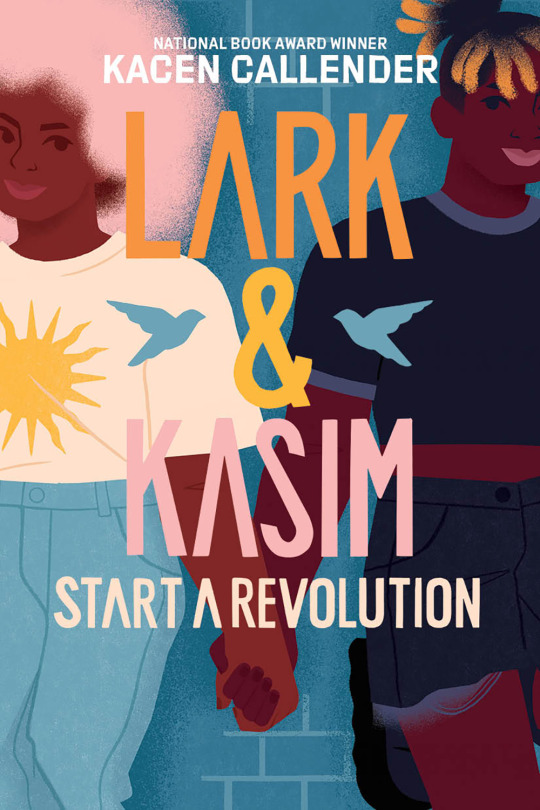


A Summer Setting for a Summer Read
A friend sent me a twitter thread asking about books set in summer and I thought...what a fantastic post that could be. We often talk about "summer reads" but what about books that are set during summer? Books that capture that magical time of "freedom" and beating the heat. A time when anything seems possible. Take a look at these books that have mysteries to solve, new relationships to explore, and lives forever changed.
Warrior Girl Unearthed by Angeline Boulley
Perry Firekeeper-Birch was ready for her Summer of Slack but instead, after a fender bender that was entirely not her fault, she’s stuck working to pay back her Auntie Daunis for repairs to the Jeep.
Thankfully she has the other outcasts of the summer program, Team Misfit Toys, and even her twin sister Pauline. Together they ace obstacle courses, plan vigils for missing women in the community, and make sure summer doesn’t feel so lost after all.
But when she attends a meeting at a local university, Perry learns about the “Warrior Girl”, an ancestor whose bones and knife are stored in the museum archives, and everything changes. Perry has to return Warrior Girl to her tribe. Determined to help, she learns all she can about NAGPRA, the federal law that allows tribes to request the return of ancestral remains and sacred items. The university has been using legal loopholes to hold onto Warrior Girl and twelve other Anishinaabe ancestors’ remains, and Perry and the Misfits won’t let it go on any longer.
Using all of their skills and resources, the Misfits realize a heist is the only way to bring back the stolen artifacts and remains for good. But there is more to this repatriation than meets the eye as more women disappear and Pauline’s perfectionism takes a turn for the worse. As secrets and mysteries unfurl, Perry and the Misfits must fight to find a way to make things right – for the ancestors and for their community.
A Scatter of Light by Malinda Lo
Aria Tang West was looking forward to a summer on Martha's Vineyard with her best friends--one last round of sand and sun before college. But after a graduation party goes wrong, Aria's parents exile her to California to stay with her grandmother, artist Joan West. Aria expects boredom, but what she finds is Steph Nichols, her grandmother's gardener. Soon, Aria is second-guessing who she is and what she wants to be, and a summer that once seemed lost becomes unforgettable--for Aria, her family, and the working-class queer community Steph introduces her to. It's the kind of summer that changes a life forever.
The Davenports by Krystal Marquis
In 1910, the Davenports are one of the few Black families of immense wealth and status in a changing United States, their fortune made through the entrepreneurship of William Davenport, a formerly enslaved man who founded the Davenport Carriage Company years ago. Now the Davenports live surrounded by servants, crystal chandeliers, and endless parties, finding their way and finding love—even where they're not supposed to.
There is Olivia , the beautiful elder Davenport daughter, ready to do her duty by getting married. . . until she meets the charismatic civil rights leader Washington DeWight and sparks fly. The younger daughter, Helen, is more interested in fixing cars than falling in love—unless it's with her sister's suitor. Amy-Rose, the childhood friend turned maid to the Davenport sisters, dreams of opening her own business—and marrying the one man she could never be with, Olivia and Helen's brother, John. But Olivia's best friend, Ruby, also has her sights set on John Davenport, though she can't seem to keep his interest . . . until family pressure has her scheming to win his heart, just as someone else wins hers.
The first book in a breathless new series, The Davenports offers a glimpse into a period of African American history often overlooked, while delivering a totally escapist, swoon-worthy read. Inspired by the real-life story of C.R. Patterson and his family, it's the tale of four determined and passionate young Black women discovering the courage to steer their own path in life—and love.
Lark & Kasim Start a Revolution by Kacen Callender
Lark Winters wants to be a writer, and for now that means posting on their social media accounts––anything to build their platform. When former best friend Kasim accidentally posts a thread on Lark's Twitter declaring his love for a secret, unrequited crush, Lark's tweets are suddenly the talk of the school—and beyond. To protect Kasim, Lark decides to take the fall, pretending they accidentally posted the thread in reference to another classmate. It seems like a great idea: Lark gets closer to their crush, Kasim keeps his privacy, and Lark's social media stats explode. But living a lie takes a toll—as does the judgment of thousands of Internet strangers. Lark tries their best to be perfect at all costs, but nothing seems good enough for the anonymous hordes––or for Kasim, who is growing closer to Lark, just like it used to be between them . . .
In the end, Lark must embrace their right to their messy emotions and learn how to be in love.
Blackout by Dhonielle Clayton, Tiffany D. Jackson, Nic Stone, Angie Thomas, Ashley Woodfolk, & Nicola Yoon
Six critically acclaimed, bestselling, and award-winning authors bring the glowing warmth and electricity of Black teen love to this interlinked novel of charming, hilarious, and heartwarming stories that shine a bright light through the dark.
A summer heatwave blankets New York City in darkness. But as the city is thrown into confusion, a different kind of electricity sparks…
A first meeting.
Long-time friends.
Bitter exes.
And maybe the beginning of something new.
When the lights go out, people reveal hidden truths. Love blossoms, friendship transforms, and new possibilities take flight.
Loveboat, Taipei by Abigail Hing Wen
When eighteen-year-old Ever Wong’s parents send her from Ohio to Taiwan to study Mandarin for the summer, she finds herself thrust among the very over-achieving kids her parents have always wanted her to be, including Rick Woo, the Yale-bound prodigy profiled in the Chinese newspapers since they were nine—and her parents’ yardstick for her never-measuring-up life.
Unbeknownst to her parents, however, the program is actually an infamous teen meet-market nicknamed Loveboat, where the kids are more into clubbing than calligraphy and drinking snake-blood sake than touring sacred shrines.
Free for the first time, Ever sets out to break all her parents’ uber-strict rules—but how far can she go before she breaks her own heart?
13 notes
·
View notes
Text

Robert Henri Born June 24,1865 Cincinnati Ohio- Died July 12,1929 New York NY.
Robert Henri was a portraitist and figure painter who was admired for his straightforward vital likeness of unusual sitters, He is remembered today as influential, progressive and charismatic founder.
Robert Henri was born a son of professional gambler and real estate developer. They lived in Nebraska and Colorado but later fled east when the father shot and killed a rancher over a land dispute. They Eventually change their last name because of scandal and the family settled in Atlantic City, New Jersey in the 1800s. Henri attended Pennsylvania Academy of The Fine Arts in Philadelphia where he studied under Thomas Anshuts, Thomas Hovender and James B Kelly. In 1888 he went to Paris and enrolled at the Academic Julian, later that summer he painted in Brittany and Barbizon and he also visited Italy prior to being admitted to Ecole des Beaux-Arts in 1881. Robert Henri return to Philadelphia in 1892 and resumed his studies at the Academy. Moreover, he initiated an influential career as an art teacher at the school of Design for Women until 1898.
In 1900 Henri settled in New York where he taught at the New York School of Arts from 1902-1908. In 1902 he began to specialize in portraiture and 1906 he was elected to the National Academy of Design. He had his first exhibition of independent artist 1910 he continued to win many awards and teach at the School of the Arts until July 12,1929 when he died of cancer.
Salome painted by Robert Henri 1902 on oil canvas measuring 77 x 37 inches display at the Ringling Museum of Art. Salome presents with a powerfully and gracefully poise of a dancer with the illustration of light and dark contrast.The way she standing accentuate her grace and femininity. Her head is tilted slightly upwards represents ambition, nobility and elegance that seems to pull you in as though she wants to tell you a secret or has an air of mystery. Her chandelier earrings represent luxury sophistication and elegance. Salome is painted as a model with upper arm bracelet portrays strength, and protection, power and status. Some people throughout history wore arm cuffs as a sign of elite social status. In the Old English poem Beowolf, arm cuffs were given as gifts to secure a bond of loyalty and allegiance. Colors are rich and dramatic reds and browns and black heighten the sense of drama that help highlight Salome model’s features and attire. The green in her attire represents the serenity and her striving to be grounded. The reds on her jewelry represents her passion of her presence in life. Her aubergine wrap represents to me the mystery of an exotic gypsy dancer.
My attention was drawn to this painting because of the contrast of the colors. Salome poses with elegance and self assurance her posture is firm and pose, exuding confidence and strength. Her eyes are penetrating direct outward in a way that comforts with out hesitation. furthermore anyone passing by can see the elegance and exotic the painting is. She exhibits a class of elegance and exotic, that shows she is tru to her self. To trust your intuition and be confident. Her posture show women how to be powerful with out saying a word, she command attention with out saying a word.

0 notes
Text



Old Federal Building and Post Office (Howard M. Metzenbaum U.S. Courthouse)
201 Superior Ave., NE.
Cleveland, OH
The Old Federal Building and Post Office, known formerly as the Federal Building and U.S. Courthouse and now as the Howard M. Metzenbaum U.S. Courthouse, is a historic courthouse and post office building located on Superior Avenue on Public Square in downtown Cleveland, Cuyahoga County, Ohio. Built in 1910, it is listed on the National Register of Historic Places. Its north side faces The Mall, and it is a monumental anchor to Cleveland's Civic Mall. Fronting both the Mall and Public Square, it was the first building erected under Cleveland's 1903 Group Plan, which illustrates the urban planning ideals of the City Beautiful movement.
New York architect Arnold W. Brunner (1857–1925) designed the building under the direction of Supervising Architect of the Treasury James Knox Taylor (1857–1929). The Federal Building formed one half of the Mall's termination at Superior Avenue. Cleveland's Public Library (1925), forming the other half of this terminus, emulates the Federal Building in scale, mass, and general overall appearance. The Howard M. Metzenbaum U.S. Courthouse is one of Cleveland's great monumental public buildings, skillfully illustrating the strong, classical characteristics of Beaux-Arts architecture. The five-story, granite-faced building was constructed between 1903 and 1910. The building covers the entire city block bounded by Rockwell Avenue on the north, Superior Avenue on the south, East Third Street on the east, and Public Square on the west.
Inspiration for the design of this Beaux Arts building came from the Place de la Concorde in Paris as well as the work of French architect and theorist Francois Blondel. The resulting design presents a rusticated first floor and 42-foot-high Corinthian order columns and pilasters on each elevation. These massive columns and pilasters define the sequence of window bays on the second, third, and fourth stories. Rusticated stone-arched windows with carved keystones adorn the first story. The more ornate second-story windows are capped with classically inspired pediments and balustraded sills. The third- and fourth-story window openings have molded surrounds and bracketed sills. Screening the fifth floor is an expansive entablature capped by a balustraded parapet that rises nine feet. A low-hipped, standing-seam copper roof crowns the building with attic dormer windows facing the interior light court. The parapets are adorned with shields and carved stone eagles at the building's corners.
The main entrance to the building is centered on the Superior Avenue facade. Granite steps lead to three rusticated stone arches once fitted with cast bronze doors and ornate bronze lanterns hang from cast bronze brackets. The original doors have been replaced. Flanking the primary entrance are two important sculptures executed by the famed sculptor Daniel Chester French (1850–1931). Jurisprudence is located on the Public Square corner, while Commerce sits at the corner of East Third Street and Superior Avenue. Jurisprudence is personified by a mother figure clasping her baby while a criminal crouches in chains. Commerce is depicted as a female figure holding a model ship in one hand while her other arm rests on a globe representing the opportunity for world trade. At her right is Electricity, symbolized by a female figure holding a magnet catching electrical sparks. Steam, located to her left, is represented by a male figure grasping a wheel.
On the interior, the grand main lobby dominates the first floor as it runs east to west across the entire length of the building. The floors, walls, and vaulted ceiling of the lobby are surfaced with marble. Original chandeliers illuminate the space. The postal service windows are located along the lobby's north wall. Marble stairs wrap around three sides of the elevator shafts, located at the east and west ends of the public lobby. Cast-bronze, spread-wing eagles standing on globes appear over each pair of elevator doors. Corner offices in the upper floors are adorned with impressive murals depicting significant events in the history of Cleveland. Among the magnificent artworks are City of Cleveland Welcomes the Arts by Will Hicok Low (1853–1932), and the Battle of Lake Erie by Rufus Fairchild Zogbaum (1849–1925). Murals in the ceremonial courtrooms on the third floor are The Common Law by Henry Siddons Mowbray (1858–1928), and The Law by Edwin Howland Blashfield (1848–1936).
The building was listed with the National Register of Historic Places on May 3, 1974, as the Old Federal Building and Post Office. On May 27, 1998, the building was officially renamed in honor of U.S. Senator Howard Metzenbaum of Ohio. A major renovation project to restore public spaces and modernize the mechanical systems was initiated in 2002. Although the primary activities of the U.S. District Court system have moved to the new Carl B. Stokes Federal Court House Building a few blocks west, the ceremonial courtrooms in the Metzenbaum Courthouse will continue to be used for public hearings and proceedings. New client agencies moving into the renovated building will include the U.S. Bankruptcy Court, the Office of the U.S. Trustee, and the U.S. Marshals Service.
0 notes
Text
Phantom of the Opera
The Phantom of the Opera is a broadway show based on a 1910 novel of the same name by Gaston Leroux. The story is set in Palais Garnier, an opera house in Paris. It is said that some of the events in the show are inspired by real life events that happened in the opera house.
The Chandelier
The falling chandelier is the most famous tragedy to happen. In the scene, the Phantom cuts the whole Chandelier loose to get revenge on Christine for falling in love with Raoul. On 20th May 1896, a counterweight, something that held the chandelier up, broke loose and fell through the ceiling. One person was killed and multiple injured.
The lake
The Palais Garnier does actually have an underground lake. In the musical and book, this is the centrepiece of the Phantoms lair. Legend says that a faceless man used to live in the lake, true or not, Leroux heard the rumour and went with it for his story. Nowadays, the only occupants of the lake are fish, and firefighters who practice swimming there.
The ghost?
There is many legends that inspired the story, one of which when a fire destroyed the companies old venue (this part is true). A ballerina died and her fiance, the pianist, was completely disfigured. Theres a rumour that he lived underground of the new venue, which could've been the faceless man???? This is obviously unclear but we can clearly see how this inspired the Phantoms living and appearance.
One of the other many rumours is the ghost who haunts the Palais Garnier. Leroux was obsessed with proving that this 'ghost' was real. In the prologue of the novel, he talks about the disappearance of Vicomte de Chagny, who disappeared to Canada for 15 years. Leroux claims that Chagny and his brother fought over Christine Daae. Insinuating a tragedy happened between the two. Vicomte is clearly the inspiration for Christines friend and lover. In the novel, it appears he believes the brother is the ghost.
Gillian Russo. (2022). Discover the real history behind 'The Phantom of the Opera'. [Online]. New York Theatre Guide. Last Updated: June 28 2022. Available at: https://www.newyorktheatreguide.com/theatre-news/news/discover-the-real-history-behind-the-phantom-o [Accessed 11 March 2024]
0 notes